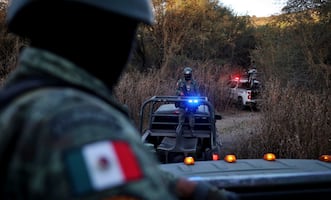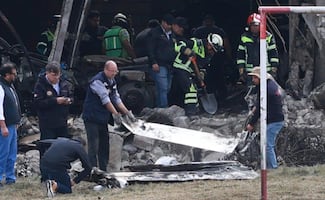Más Información

Vinculan a proceso a "El Yeicob", socio del empresario Raúl Rocha, por delincuencia organizada; le dictan prisión preventiva

Vinculan a proceso a "El Limones" por narcotráfico y posesión de armas; continúa en prisión en el Altiplano

UIF respalda sanciones de EU contra el Cártel de Santa Rosa de Lima; fortalece esfuerzos conjuntos para reducir criminalidad, destaca
They return defeated, sad, humiliated, dejected, fearful and exhausted. They arrive with their dignity crushed. They come back hopeless to a country from which they had to migrate by irregular routes to escape from the violence and the economic crisis. It is the ordeal of thousands of Guatemalans who are deported from the United States.
It is a return without glory.
After dealing with all sorts of dangers on a land journey across Mexico , subjected to Coyotes or human traffickers, irregular immigrants face the end of the adventure in which they launched themselves in search of personal and family dreams. Everything ends in the hangar of the Guatemalan Air Force in La Aurora international airport , the main one of Guatemala .
Full of deportees, US government airplanes land on the terminal's runway two or three times a week unloading Guatemalans who, without visas or other permits to enter and reside in US territory, were caught in desert areas, rural regions or American urban concentrations, facing the reality of deportation.
After fulfilling a slow identification and control process inside the military base, quickly, in silence, without hiding their feelings of pain and defeat, they go out into the world through a narrow door returning to the reality of their situation. Sometimes relatives are waiting for them, while others leave in solitude and walk aimlessly.
In the middle of the scene, traders cry “ Mexican pesos, dollars ”. They offer to exchange those currencies for Guatemalan quetzales , so the deportees can try to cover their immediate expenses.
In the same place, there are carriers as well, who charge different sums of money for transporting them by buses to their new path in Guatemala. With different destinations, whether to the east, the west or any other way, buses are easily filled with a large clientele, tired and eager to leave that place as soon as possible, trying to forget, without delay, the ghosts of the painful and always dreaded deportation.
The arrival
As if he was lost in time and space, he leaves the base and hesitates where to turn. “I have never been able to enter and stay in the United States,” says a Guatemalan who identifies himself as Miguel Pedro Ander , 31, who in the second trimester of 2017 undertook his second journey by irregular routes to US territory from Guatemala, where he has a wife and two daughters. Reluctant to talk to the press at the exit of the military facility, he barely babbles: “I was arrested” in Arizona and tells that his entry to the US was by the Mexican state of Sonora , bordering that American region.
He looks from one side to another of the congested street. Lost, he walks fast. He does not want to answer any more questions. In an ironic moment, he and other deportees pass in front of the offices of a commercial airline adjacent to the base and in the parking lot of which remain about 10 luxury cars of other Guatemalans who take advantage of the publicized fare offers to travel legally to the US.
Annoyed, discomforted and frustrated, Ander and the others are now just a figure from the immigration statistics of the US and Guatemalan air deportations and they belong once again to the bulk of the population that is part of the old phenomenon of social exclusion victims in a country with a long history as an ejector of its inhabitants who flee from the socioeconomic circle and from violence: more than half of the 16.5 million Guatemalans live in diverse poverty ranges.
Trapped again in their permanent reality, they must survive in a country that in December 2016 celebrated 20 years of the end of a war that, from 1960 to 1996, left more than 200,000 dead and disappeared, and that suffers violence by Maras or gangs and organized crime that, according to the Guatemala's National Institute of Forensic Sciences, reports 17,110 homicides from 2014 to 2016 or more than 15.5 per day.
It is the return without glory... with a new aggravating factor: the reinsertion is another ordeal, because the deportees return to a nation that maintains the same conditions that force them to emigrate. “Reinsertion is extremely hard and difficult,” says Guatemalan Majo Girón , co-director of Labor Connection ( Conexión Laboral ), a non-state firm in Guatemala that helps groups of deportees to link to the internal labor market.
“Their situation is very fragile because they fear to return to face greatest hazards once again. They come unmotivated,” she adds. “The deportees arrive with several needs. We guide them with English, computer and typing classes and we advise them to look for a job”, says the Guatemalan José Andrés Ordóñez , co-director of the organization. In interviews with EL UNIVERSAL , both explain that the main aid to the deportees is emotional, to defeat their own mental attitude of demotivation and convince them that they should and that they can get decent employment.
Reduction
Based on its consular network, the Guatemalan Ministry of Foreign Affairs estimates that 2,178,219 Guatemalans live ( legally or illegally ) in the US. Other official projections suspect that the figure approaches 3 million. Statistics that the Directorate General of Immigration in Guatemala provided to EL UNIVERSAL show a decrease in the numbers of deported immigrants by plane from the US. A total of 16,655 Guatemalans were deported in 2017 from January 1 to August 3, an average of 77.46 per day.
But the 2016 and 2015 data reveals another scenario. In 2016, from January 1 to August 31, there were 21,971 cases, 90.41 per day, while in the same period in 2015 there were 21,481, being 88.39 per day.
The 2016 total was 35,465, an average of 96.89 every 24 hours, while in 2015 it reached 31,443 or 86.14 per day. The figures, however, remain far from those reported in 2013, with 51,157 or 137.59 per day, and in 2014, with 140.15.
In this context, Guatemala's official information on Guatemalan deportations by land from Mexico confirms larger figures. In 2017, from January 1 to July 31, there were 16,897 or 79.70 per day. In the same period of 2016 there were 29,768 or 139.75 per day, while in those seven months of 2015, 44,718 or 210.93 per day were registered.
The data indicates that in 2013, with 29,598 and 81.09 per day, there were fewer deportees than in seven months in 2016. In 2016, the number of deportees reached 56,142 with 153.39 per day.
From 2013 to 2016, with 168,286 deportees from the United States, the daily average was 115.18. From 2013 to 2016, with 205,899 deportees from Mexico by land, the daily average stood at 140.93, which is equivalent to 25.75 more per day than those expelled by the US.
Without a difference
In consultation with this newspaper, the Directorate reports that despite the policy of the US president , Republican Donald Trump , regarding the rejection of irregular immigrants, ratified in January of this year, Guatemala figures do not record a "notable" difference of the deportations in comparison to previous periods.
Despite the fear that Trump, with its plan to appeal to multiple formulas to contain illegal migration, will unleash a wave of massive deportations, the figures are not rising, although the Directorate prefers to wait for the last quarter of 2017. In the meantime, flights continue arriving every week to Guatemala with deportees, always nostalgic for the lost illusion... in a return without glory.
sg
Noticias según tus intereses
[Publicidad]
[Publicidad]











